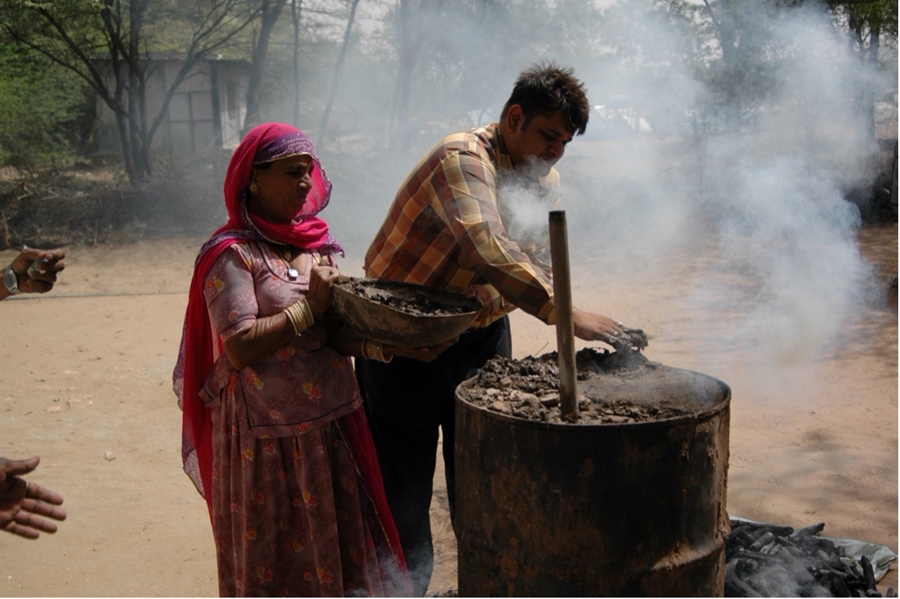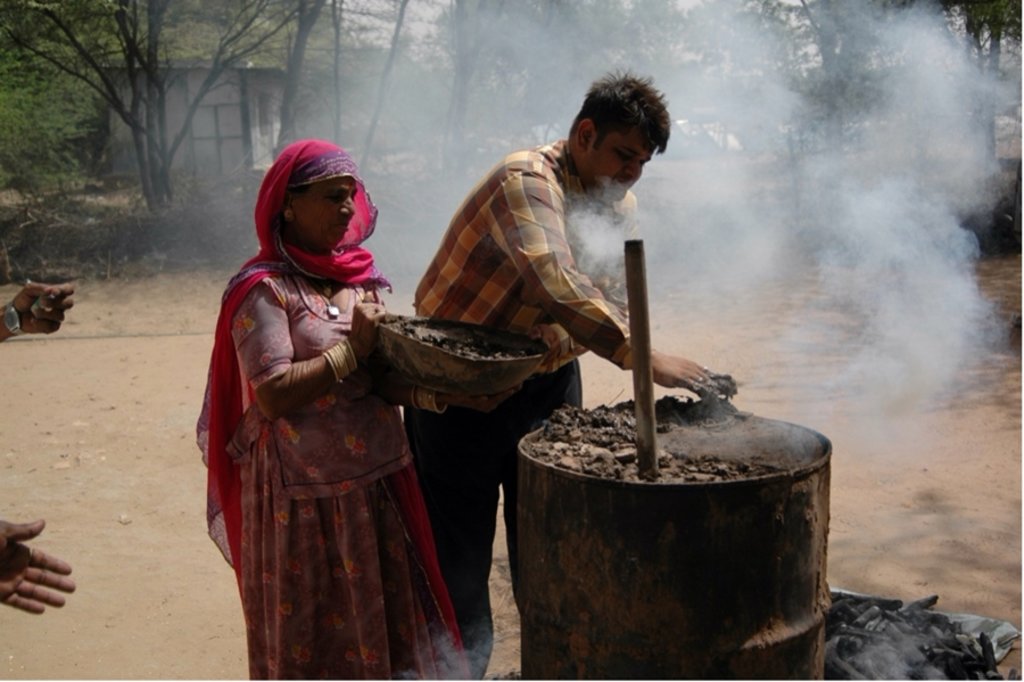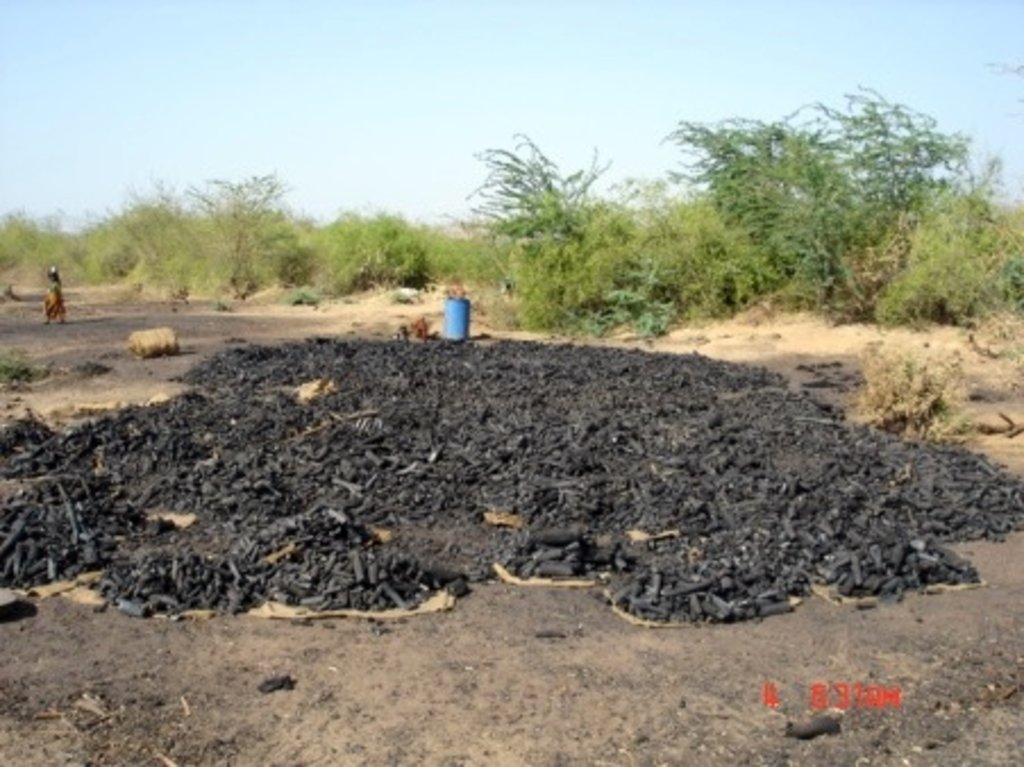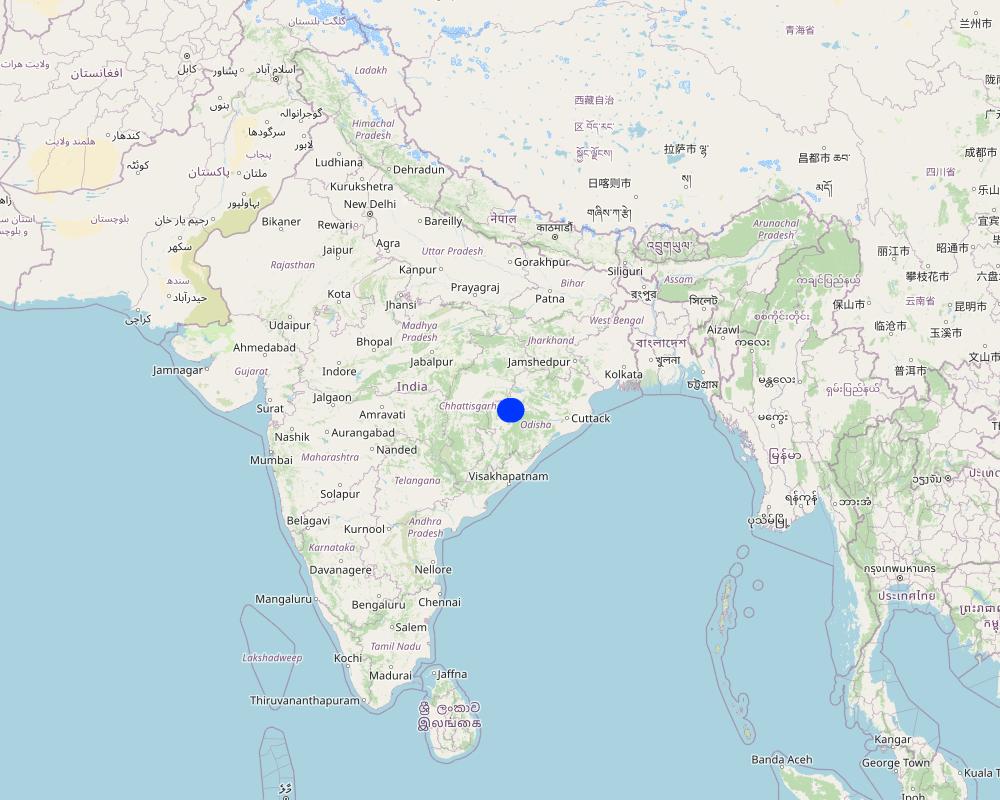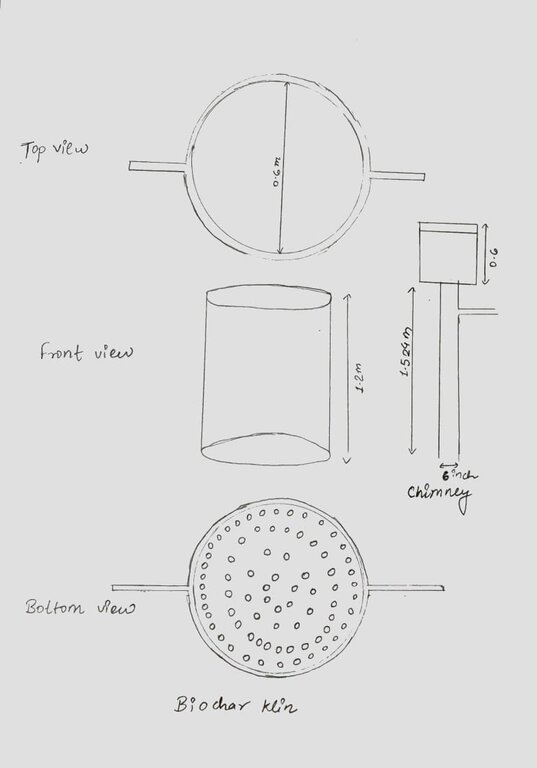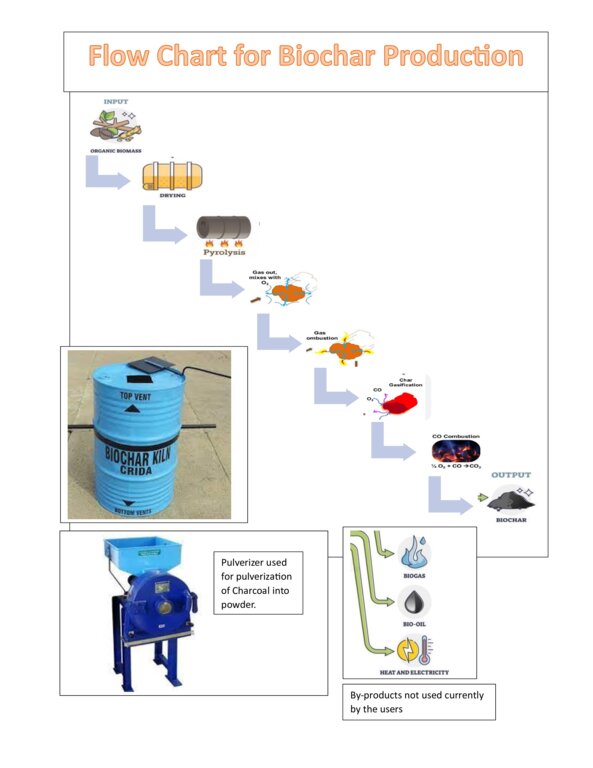Sustainable Biochar Production Through Agroforestry Systems And Its Application [India]
- Creation:
- Update:
- Compiler: Santosh Gupta
- Editors: Kim Arora, Stephanie Jaquet, Tabitha Nekesa, Ahmadou Gaye, Siagbé Golli
- Reviewers: Udo Höggel, Sally Bunning
technologies_6735 - India
View sections
Expand all Collapse all1. General information
1.2 Contact details of resource persons and institutions involved in the assessment and documentation of the Technology
Name of project which facilitated the documentation/ evaluation of the Technology (if relevant)
Soil protection and rehabilitation for food security (ProSo(i)l)Name of the institution(s) which facilitated the documentation/ evaluation of the Technology (if relevant)
Deutsche Gesellschaft für Internationale Zusammenarbeit (GIZ) - GermanyName of the institution(s) which facilitated the documentation/ evaluation of the Technology (if relevant)
International Centre for Research in Agroforestry (ICRAF) - KenyaName of the institution(s) which facilitated the documentation/ evaluation of the Technology (if relevant)
Ecociate Consultants (Ecociate Consultants) - India1.3 Conditions regarding the use of data documented through WOCAT
The compiler and key resource person(s) accept the conditions regarding the use of data documented through WOCAT:
Yes
1.4 Declaration on sustainability of the described Technology
Is the Technology described here problematic with regard to land degradation, so that it cannot be declared a sustainable land management technology?
No
Comments:
The application of biochar to the soil is a technology that can prevent or reduce land degradation by improving soil health through the addition of organic matter, increase soil fertility and the water retention capacity of soils.
1.5 Reference to Questionnaire(s) on SLM Approaches (documented using WOCAT)

Developing professional standards in the installation, maintenance and … [Mali]
Ensure the sustainability of schemes and continuity of production, and reduce production costs
- Compiler: Dieter Nill
2. Description of the SLM Technology
2.1 Short description of the Technology
Definition of the Technology:
Biochar is a carbon-rich, solid material derived from a wide range of biomass or organic waste through a thermochemical method. It is an organic charcoal material that is the final product of pyrolysis, or high-temperature burning of agricultural biomass without oxygen. Surplus crop residues, agricultural waste, and wood from sustainable sources are used as feedstock (raw material). Such biochar production is linked with agroforestry plantation and agriculture to improve soil health and ensuring sustainable feedstock availability.
2.2 Detailed description of the Technology
Description:
Introduction and Background
Intensive cropping systems coupled with monocropping and high usage of synthetic fertilizers have led to the degradation of soils and depletion of nutrients directly affecting agricultural productivity and farmers' income. Farmers in the Balangir district of Odisha are facing similar challenges. To address these issues and promote sustainable farming practices, a biochar production initiative was introduced by utilizing crop residues and waste material from forests to produce biochar, a carbon-rich material that enhances soil fertility and soil structure. The initiative is a part of the Pro-Soil Project of Deutsche Gesellschaft für Internationale Zusammenarbeit (GIZ), India and implemented by the International Centre for Research in Agroforestry (ICRAF). The technology (a kiln for biochar production) and technical inputs for biochar production were sourced from the Indian Institute of Soil Science, Bhopal.
Biochar is a type of charcoal produced from biomass like agricultural or forest waste or organic materials through a process called pyrolysis. The application of sustainable biochar technology in agroforestry systems can lead to better soil structure, increased water retention, reduced nutrient leaching, and improved crop yields. Moreover, it aids in mitigating greenhouse gas emissions by locking carbon into soil for an extended period.
In the project region farmers used crop residues such as rice straw, wheat straw and residue of other crops along with non-usable biomass from local forests, such as branches, twigs, and leaves, to supplement the feedstock for the pyrolysis. Since the District has large forest areas, the availability of forest waste is no problem. The biochar produced was applied into existing crops fields as well as into agroforestry system. Aiming to promote agroforestry, the project promoted the integration of trees (both fruits and timber) and shrubs into existing agricultural practices. Agroforestry offers multiple benefits such as improved soil health, biodiversity, and carbon sequestration. When sustainable biochar production is integrated into these systems, it can create a sustainable cycle where agricultural waste is converted into biochar, which then enhances soil fertility and sequesters carbon when added back into the soil.
The project has actively involved women farmers, entrepreneurial youth, and farmers' groups in the collection, production and application process of biochar thus promoting community participation and creating awareness about the benefits of biochar.
Implementation
The biochar kiln technology, obtained from the Indian Institute of Soil Science, in Bhopal, is employed to convert biomass into biochar through pyrolysis. This technology ensures efficient and controlled production of high-quality biochar. The collected biomass undergoes a controlled pyrolysis process inside the biochar kiln, where it is burned in the relative absence of oxygen. Technical specialization during production includes kiln temperature control, feedstock preparation, and the management of pyrolysis gases to ensure efficient biochar production. This results in the conversion of biomass into biochar, also leaving behind bioenergy-rich gases. Quality control measures are implemented to ensure the production of biochar with optimal characteristics, including high carbon content, porosity, and stability.
The Biochar kiln used was designed with the aim to optimize temperature control and ensure efficient conversion of biomass. An efficient loading mechanism allows easy and controlled feeding of biomass into the kiln. This ensures a consistent flow of material during the pyrolysis process. Although local kilns are usually not equipped with temperature control mechanisms to regulate the pyrolysis temperature, the temperature in the kilns may alternatively be regulated through the rate of feeding biomass into the kilns. Such kilns usually have some safety features and proper ventilation so to prevent accidents.
To implement this technology the ICRAF conducted training sessions for farmers on the proper preparation and application of biochar. The trainings were focused on the following aspects:
-The collection and drying process for agriculture and forest waste
-The management of operations for the biochar kiln including the loading of raw material (feedstock) into the kiln, its burning, operation-timing, period check, volumes of raw material to be fed etc.
-Precautions to be taken during the process
-The quality check of prepared biochar charcoal and the process for pulverizing it
-Dosage recommendations for different crops as per local conditions
-The mixing of biochar with cow dung and cow urine before application
-Integration with existing farming practices and the long-term benefits of biochar on soil health
Impact and Knowledge Transfer
The biochar acts as a soil conditioner, enhancing water retention, nutrient availability, and microbial activity. The benefits and impacts on improved fertility, increased water retention, and reduced nutrient leaching, lead to higher crop yields and resilience against climate variability, carbon sequestration aids in reducing greenhouse gas emissions, contributing to global efforts to combat climate change, and utilizing agricultural residues reduces air pollution from open burning and provides a sustainable solution for organic waste disposal. Land users appreciated the enhanced soil productivity and environmental benefits brought by biochar. Overall, the Sustainable Biochar Production Technology represents a promising approach in sustainable agriculture and environmental stewardship.
The project team, in collaboration with local agricultural extension services and the Indian Institute of Soil Science, monitored the impact of biochar application on soil health parameters. This involved regular soil testing, crop yield assessments and feedback from participating farmers. In fact, they also measured the impact of biochar made from different feedstock (raw materials). Success stories were shared with neighboring communities, public stakeholders and researchers and encouraged the further adoption of sustainable soil management practices.
The biochar production initiative in the Balangir District of Odisha in India demonstrates a sustainable approach to addressing soil health issues using locally available resources. Through the collaboration between ICRAF and GIZ, this project not only improves soil fertility but also empowers local communities by providing them with sustainable solutions for agricultural challenges. The success of this intervention serves as a model for future initiatives aimed at promoting environmentally friendly and community-driven approaches to agriculture.
2.3 Photos of the Technology
2.4 Videos of the Technology
Comments, short description:
https://www.youtube.com/watch?v=qHpIPVX2mR8&t=8s
Location:
Bhopal, MP
Name of videographer:
ICAR-CIAE
2.5 Country/ region/ locations where the Technology has been applied and which are covered by this assessment
Country:
India
Region/ State/ Province:
Odisha
Specify the spread of the Technology:
- applied at specific points/ concentrated on a small area
Is/are the technology site(s) located in a permanently protected area?
No
Map
×2.6 Date of implementation
Indicate year of implementation:
2021
2.7 Introduction of the Technology
Specify how the Technology was introduced:
- during experiments/ research
- through projects/ external interventions
Comments (type of project, etc.):
Piloting best practices to produce biochar using diverse feedstock and its application
3. Classification of the SLM Technology
3.1 Main purpose(s) of the Technology
- improve production
- reduce, prevent, restore land degradation
- conserve ecosystem
- preserve/ improve biodiversity
- adapt to climate change/ extremes and its impacts
- create beneficial economic impact
3.2 Current land use type(s) where the Technology is applied
Land use mixed within the same land unit:
No

Cropland
- Annual cropping
- Tree and shrub cropping
Annual cropping - Specify crops:
- cereals - millet
- cereals - rice (upland)
Tree and shrub cropping - Specify crops:
- fodder trees (Calliandra, Leucaena leucocephala, Prosopis, etc.)
- fruits, other
Number of growing seasons per year:
- 2
Specify:
Mostly farmers are cultivating during the monsoon season as these are the rainfed farmers. Some farmers with irrigation facilities are cultivating in winter season as well
Is intercropping practiced?
Yes
If yes, specify which crops are intercropped:
Millets and other cereals
Is crop rotation practiced?
Yes
If yes, specify:
Cereals, Pulses, Fodder crops

Forest/ woodlands
- (Semi-)natural forests/ woodlands
(Semi-)natural forests/ woodlands: Specify management type:
- Dead wood/ prunings removal
Are the trees specified above deciduous or evergreen?
- mixed deciduous/ evergreen
Products and services:
- Timber
- Fuelwood
- Fruits and nuts
- Grazing/ browsing

Settlements, infrastructure
- Settlements, buildings
3.3 Has land use changed due to the implementation of the Technology?
Has land use changed due to the implementation of the Technology?
- No (Continue with question 3.4)
3.4 Water supply
Water supply for the land on which the Technology is applied:
- mixed rainfed-irrigated
Comments:
Most farmers are cultivating in rainfed conditions while some also have irrigation facilities
3.5 SLM group to which the Technology belongs
- improved ground/ vegetation cover
- water harvesting
- waste management/ waste water management
3.6 SLM measures comprising the Technology

agronomic measures
- A1: Vegetation/ soil cover
- A2: Organic matter/ soil fertility
- A3: Soil surface treatment
- A6: Residue management

vegetative measures
- V4: Replacement or removal of alien/ invasive species
- V5: Others

management measures
- M6: Waste management (recycling, re-use or reduce)

other measures
Specify:
Climate resilient soil management by application of biochar using varied feedstock (rwa material) generated through agroforestry
3.7 Main types of land degradation addressed by the Technology

soil erosion by water
- Wt: loss of topsoil/ surface erosion

physical soil deterioration
- Ps: subsidence of organic soils, settling of soil

biological degradation
- Bl: loss of soil life
3.8 Prevention, reduction, or restoration of land degradation
Specify the goal of the Technology with regard to land degradation:
- reduce land degradation
- restore/ rehabilitate severely degraded land
4. Technical specifications, implementation activities, inputs, and costs
4.1 Technical drawing of the Technology
Technical specifications (related to technical drawing):
The single barrel biochar klin was developed by the Indian Institute of Soil Sciences in Bhopal (IISS). The Kiln had already been designed and commercialised by the IISS. Land users can buy a metallic kiln unit from the IISS or get it fabricated from local fabricators based on the design specifications suggested in the drawing.
Author:
Payal Dewangan
Date:
12/07/2023
Technical specifications (related to technical drawing):
The flowchart provides a step by step guide for biochar production in the project area by land users
Author:
Payal and Santosh
Date:
20/11/2023
4.2 General information regarding the calculation of inputs and costs
Specify how costs and inputs were calculated:
- per Technology unit
Specify unit:
200 L capacity
Specify dimensions of unit (if relevant):
Litre
other/ national currency (specify):
INR
If relevant, indicate exchange rate from USD to local currency (e.g. 1 USD = 79.9 Brazilian Real): 1 USD =:
80.0
Indicate average wage cost of hired labour per day:
204 Rupees
4.3 Establishment activities
| Activity | Timing (season) | |
|---|---|---|
| 1. | Purchase of biochar kiln unit | Can be done any time during the year but need to be ready before the month of September |
| 2. | Purchase of pulveriser | Need to be purchased once and before the start of biochar production |
Comments:
Both biochar kiln and pulveriser are fixed investments and can last up to 5 years
4.4 Costs and inputs needed for establishment
| Specify input | Unit | Quantity | Costs per Unit | Total costs per input | % of costs borne by land users | |
|---|---|---|---|---|---|---|
| Equipment | Biochar Klin | Rs. | 1.0 | 7000.0 | 7000.0 | |
| Equipment | Pulvariser unit | Rs. | 1.0 | 20000.0 | 20000.0 | |
| Total costs for establishment of the Technology | 27000.0 | |||||
| Total costs for establishment of the Technology in USD | 337.5 | |||||
If land user bore less than 100% of costs, indicate who covered the remaining costs:
The project paid towards the fixed investment costs of biochar kiln and pulverizier unit
4.5 Maintenance/ recurrent activities
| Activity | Timing/ frequency | |
|---|---|---|
| 1. | Collecting the crop residues and forest waste | Needs to be collected and dried before the start of biochar production unit (September and June) |
| 2. | Preparation of Biochar | Before the sowing of Rabi (winter) and Kharif (summer) seasons (Months of September/October and June/July) |
| 3. | Application of biochar in the field | During the cropping season |
Comments:
These activities may vary based on the cropping pattern and farmers' need of biochar application
4.6 Costs and inputs needed for maintenance/ recurrent activities (per year)
| Specify input | Unit | Quantity | Costs per Unit | Total costs per input | % of costs borne by land users | |
|---|---|---|---|---|---|---|
| Labour | Preparation of biochar | Person-day | 2.0 | 200.0 | 400.0 | 100.0 |
| Labour | Application of biochar in the field | Person-day | 1.0 | 200.0 | 200.0 | 100.0 |
| Fertilizers and biocides | Farmyard manure | Rs. | 20.0 | 5.0 | 100.0 | 100.0 |
| Fertilizers and biocides | Fertilizer | Rs. | 50.0 | 7.0 | 350.0 | 100.0 |
| Total costs for maintenance of the Technology | 1050.0 | |||||
| Total costs for maintenance of the Technology in USD | 13.13 | |||||
Comments:
The application of biochar was practiced by land users twice in a year, before sowing kharif and rabi crops. The amount of maintenance activities of the technology is count double for a year as farmers are practicing the biochar technology for two seasons in a year.
4.7 Most important factors affecting the costs
Describe the most determinate factors affecting the costs:
The investment towards the purchase of the kiln- and the pulveriser unit. In the documented project, the investment costs were borne by the project. Therefore, smallholder farmers may find it difficult to purchase the hardware units of kiln and pulveriser, given such investment costs.
5. Natural and human environment
5.1 Climate
Annual rainfall
- < 250 mm
- 251-500 mm
- 501-750 mm
- 751-1,000 mm
- 1,001-1,500 mm
- 1,501-2,000 mm
- 2,001-3,000 mm
- 3,001-4,000 mm
- > 4,000 mm
Specify average annual rainfall (if known), in mm:
1288.00
Indicate the name of the reference meteorological station considered:
Bhubaneshwar, Odisha
Agro-climatic zone
- sub-humid
The District is located under the West Central Table Land Agro Climatic Zone characterized by hot and sub-humid climate
5.2 Topography
Slopes on average:
- flat (0-2%)
- gentle (3-5%)
- moderate (6-10%)
- rolling (11-15%)
- hilly (16-30%)
- steep (31-60%)
- very steep (>60%)
Landforms:
- plateau/plains
- ridges
- mountain slopes
- hill slopes
- footslopes
- valley floors
Altitudinal zone:
- 0-100 m a.s.l.
- 101-500 m a.s.l.
- 501-1,000 m a.s.l.
- 1,001-1,500 m a.s.l.
- 1,501-2,000 m a.s.l.
- 2,001-2,500 m a.s.l.
- 2,501-3,000 m a.s.l.
- 3,001-4,000 m a.s.l.
- > 4,000 m a.s.l.
Indicate if the Technology is specifically applied in:
- not relevant
Comments and further specifications on topography:
Balangir District is divided into four Agro-Ecological situations (AES) and characterized by a hot dry summer and highly erratic rainfall distribution of south-west monsoon rains, i.e., (i) plain land irrigated, (ii) plain land rainfed (iii) undulating plain drought-prone and (iv) undulating sub-mountainous tract rainfed.
The altitude of the Bolangir district is 207 masl.
5.3 Soils
Soil depth on average:
- very shallow (0-20 cm)
- shallow (21-50 cm)
- moderately deep (51-80 cm)
- deep (81-120 cm)
- very deep (> 120 cm)
Soil texture (topsoil):
- coarse/ light (sandy)
- fine/ heavy (clay)
Soil texture (> 20 cm below surface):
- coarse/ light (sandy)
- fine/ heavy (clay)
Topsoil organic matter:
- low (<1%)
If available, attach full soil description or specify the available information, e.g. soil type, soil PH/ acidity, Cation Exchange Capacity, nitrogen, salinity etc.
Mixed red and yellow soils occur as catenary associations in undulating and rolling terrains which differ in depth, texture, and color. Red and yellow soils are moderately shallow in depth and coarse-textured. Upland soils are shallower and lighter in texture than low-land soils.
Red and black soils are light to medium textured having neutral pH. These soils occur in mixed forms of both red & black soil together in which black soils occur in patches within the predominant red soils.
Black soils are mostly found in Puintala Block and in some parts of Loisingha Block. The soils are heavier in texture having clay content more than 30%. Clay minerals are predominant with smectites due to which deep cracks are seen to develop during summer.
Laterite soils are generally distributed in a few limited patches in the Balangir District. These soils are loamy sand to sandy loam in the surface having a hard clay pan in the subsoil. Crusting is a problem in upland literite.
Brown forest soils are mostly found in Khaprakhol, Tureikela, Bangomunda, Titilagarh, Saintala, and Gudvella Block. These soils are brown to grey-brown in color, light textured, and acidic in reaction.
5.4 Water availability and quality
Ground water table:
5-50 m
Availability of surface water:
good
Water quality (untreated):
poor drinking water (treatment required)
Water quality refers to:
both ground and surface water
Is water salinity a problem?
Yes
Specify:
Balangir District falls within the Western Plateau and Hills Zone of Odisha, characterized by a semi-arid climate. The agro-climatic conditions include hot summers, limited rainfall, and erratic monsoons, which pose challenges for agriculture due to water scarcity. In many regions of Odisha, including Balangir, water salinity is a significant concern, especially in areas relying on groundwater sources.
Is flooding of the area occurring?
No
Comments and further specifications on water quality and quantity:
The groundwater level at 3 meters below ground level in 2019 indicates water table that lies within 3-5 meters below ground level (m bgl) or less is considered shallow. This level often indicates good accessibility to groundwater, making it relatively easier for extraction using shallow wells or hand pumps.
5.5 Biodiversity
Species diversity:
- high
Habitat diversity:
- high
Comments and further specifications on biodiversity:
The Odisha Government has declared the Gandhamardan Hill Range in Bargarh and Balangir Districts a Biodiversity Heritage Site (BHS).
5.6 Characteristics of land users applying the Technology
Market orientation of production system:
- subsistence (self-supply)
Off-farm income:
- less than 10% of all income
Relative level of wealth:
- poor
Individuals or groups:
- individual/ household
- groups/ community
Level of mechanization:
- manual work
- animal traction
Gender:
- women
- men
Age of land users:
- youth
- middle-aged
Indicate other relevant characteristics of the land users:
There are a number of women self help groups and farmer producer organisations being formed in the district as part of Government programs
5.7 Average area of land used by land users applying the Technology
- < 0.5 ha
- 0.5-1 ha
- 1-2 ha
- 2-5 ha
- 5-15 ha
- 15-50 ha
- 50-100 ha
- 100-500 ha
- 500-1,000 ha
- 1,000-10,000 ha
- > 10,000 ha
Is this considered small-, medium- or large-scale (referring to local context)?
- small-scale
5.8 Land ownership, land use rights, and water use rights
Land ownership:
- individual, titled
Land use rights:
- individual
Water use rights:
- communal (organized)
- individual
Are land use rights based on a traditional legal system?
No
Comments:
The majority of the farmers in the district are smallholder farmers with agriculture being mostly rained, except some areas with irrigation facilities from the nearby dam
5.9 Access to services and infrastructure
health:
- poor
- moderate
- good
education:
- poor
- moderate
- good
technical assistance:
- poor
- moderate
- good
employment (e.g. off-farm):
- poor
- moderate
- good
markets:
- poor
- moderate
- good
energy:
- poor
- moderate
- good
roads and transport:
- poor
- moderate
- good
drinking water and sanitation:
- poor
- moderate
- good
financial services:
- poor
- moderate
- good
Comments:
The district is located in the interior parts of eastern India and considered as a backward district with poor access to infrastructure and other facilities
6. Impacts and concluding statements
6.1 On-site impacts the Technology has shown
Socio-economic impacts
Production
crop production
Comments/ specify:
For Wood Biochar or Wood Coconut Husk Biochar (WCB), or Crop Residue Biochar (CRB) the highest grain yield of the crop was recorded with the highest dose of biochar, fertilizer, and manure application. Also, it's application significantly improved the straw yield
crop quality
Comments/ specify:
The application of Wood Biochar or Wood Coconut Husk Biochar (WCB), or Crop Residue Biochar (CRB) with manure also significantly improved the quality of the crop
fodder production
Comments/ specify:
It was found with significantly improved straw yield the availability of fodder for the livestock also increased
fodder quality
Comments/ specify:
It was recorded that the quality of the crop also the quality of the straw also improved.
risk of production failure
Comments/ specify:
It was observed that the crop in which the application of biochar was with the manure and fertilizer, the crop had better adaptation and standing properties in comparison to another crop without the application of biochar.
land management
Income and costs
farm income
Comments/ specify:
The yield for the crop in which application was done was increased which led to an increase in income
Socio-cultural impacts
food security/ self-sufficiency
Ecological impacts
Water cycle/ runoff
harvesting/ collection of water
Comments/ specify:
Water retention from the soil increased because of the increase in soil organic matter and carbon content
surface runoff
Comments/ specify:
The water holding capacity of the water increased leading to less surface runoff from the field.
evaporation
Soil
soil moisture
Comments/ specify:
With an increase in soil organic matter and improved soil texture the soil moisture increased
soil loss
Comments/ specify:
The semi-arid climate and limited rainfall, combined with sporadic and intense monsoons, can lead to soil erosion. When rainfall does occur, it can cause rapid runoff, carrying away the topsoil due to the lack of vegetation cover or inadequate soil conservation measures.
nutrient cycling/ recharge
Comments/ specify:
The application of biochar with manure and fertilizers not only increased the nutrients in the soil but also increased the nutrient uptake of plants from the soil.
salinity
Comments/ specify:
Biochar can act as a soil amendment to moderate soil pH depending on the initial pH level. Scientifically, biochar tends to be pH neutral, so its impact on soil pH depends on the existing soil condition. The impact of biochar on pH is often gradual and depends on various factors like the type and composition of biochar, soil characteristics and environmental conditions. Biochar acts more as a buffer, stabilizing soil pH over time rather than making drastic immediate changes.
soil organic matter/ below ground C
Biodiversity: vegetation, animals
Vegetation cover
Comments/ specify:
The plant biomass as well as the vegetative growth of the plant showed a significant positive reaction to the biochar application on crops
biomass/ above ground C
plant diversity
pest/ disease control
Comments/ specify:
Resistance of the crop increases with better uptake of K from the soil. Plants become more resistant to disease and pests.
Climate and disaster risk reduction
emission of carbon and greenhouse gases
Specify assessment of on-site impacts (measurements):
In the context of regions like Balangir, where salinity and soil loss are concerns, biochar's ability to improve soil structure and fertility without altering pH drastically could be beneficial. It helps mitigate soil erosion by enhancing soil health and resilience, thus contributing to sustainable agriculture practices in these challenging environments.
6.3 Exposure and sensitivity of the Technology to gradual climate change and climate-related extremes/ disasters (as perceived by land users)
Gradual climate change
Gradual climate change
| Season | increase or decrease | How does the Technology cope with it? | |
|---|---|---|---|
| annual temperature | increase | moderately | |
| seasonal temperature | summer | increase | moderately |
| annual rainfall | decrease | well | |
| seasonal rainfall | wet/ rainy season | decrease | moderately |
Climate-related extremes (disasters)
Climatological disasters
| How does the Technology cope with it? | |
|---|---|
| drought | moderately |
Comments:
Overall biochar improves the soil health and helps soil to maintain the moisture thus it is better suited to some of the climatic conditions such as low rainfall, delayed rains etc. However in case of extreme climatic conditions, technology alone may not mitigate the impact.
6.4 Cost-benefit analysis
How do the benefits compare with the establishment costs (from land users’ perspective)?
Short-term returns:
positive
Long-term returns:
very positive
How do the benefits compare with the maintenance/ recurrent costs (from land users' perspective)?
Short-term returns:
very positive
Long-term returns:
very positive
Comments:
The benefits of technology to soil health, crop productivity and crop quality is much higher than the cost of establishment and maintenance
6.5 Adoption of the Technology
- single cases/ experimental
If available, quantify (no. of households and/ or area covered):
100
Of all those who have adopted the Technology, how many did so spontaneously, i.e. without receiving any material incentives/ payments?
- 0-10%
Comments:
It was mostly done as part of the PRO-SOIL PROJECT
6.6 Adaptation
Has the Technology been modified recently to adapt to changing conditions?
Yes
If yes, indicate to which changing conditions it was adapted:
- labour availability (e.g. due to migration)
Specify adaptation of the Technology (design, material/ species, etc.):
Refinements in pyrolysis methods and technologies to produce biochar with specific characteristics suited to diverse soil types and climate conditions. This includes adjusting temperature, duration, and feedstock to optimize biochar properties like porosity and water retention capacity. Innovations in application techniques to improve the efficiency and effectiveness of biochar incorporation into agricultural systems. This involves exploring precision application methods, such as localized placement or mixing with organic amendments, to ensure better distribution and utilization of biochar in the root zone. Emphasis on integrating biochar technology into climate-smart agricultural practices, focusing on sustainable intensification while adapting to changing climatic conditions. This involves promoting practices that enhance resilience to drought, water conservation and soil fertility improvement.
6.7 Strengths/ advantages/ opportunities of the Technology
| Strengths/ advantages/ opportunities in the land user’s view |
|---|
| The soil moisture, soil texture, water retention and water-holding capacity of the soil increases. The uptake of nutrients increases which leads to less application of fertilizers in the field |
| There was an increase in crop yield, straw yield, vegetative mass growth, more grains or fruits per plant, and fewer pests & disease attacks on the plants were noticed |
| The better use of crop residue from the field increase the soil fertility and promoted better crop growth |
| Strengths/ advantages/ opportunities in the compiler’s or other key resource person’s view |
|---|
| The use of biochar helps to combat the climate crisis by sequestering atmospheric carbon into soil as well as processing agricultural and other waste into useful clean energy |
| The application of biochar significantly changes the soil’s properties (texture, porosity, bulk density, particle density, surface area, pore size distribution, cation exchange capacity, pH, and water-holding capacity) which, directly influence plant growth |
| High porosity and a large surface area of biochar provide space for micro-organisms that are beneficial for the soil and help in binding important anions and cations, improving soil health and enhancing crop productivity |
| Reduced nitrous oxide and methane emissions when biochar is applied to the soil |
6.8 Weaknesses/ disadvantages/ risks of the Technology and ways of overcoming them
| Weaknesses/ disadvantages/ risks in the land user’s view | How can they be overcome? |
|---|---|
| Need large quantities of wood and crop residue for biochar production on a larger scale |
A better planning for crop residue management and access to communities to collect forest waste from forest can easily address this problem Exploring alternative biomass sources like agricultural residues, crop waste, or dedicated energy crops can reduce reliance on wood or coconut shells, promoting sustainable sourcing. Also, advancements in pyrolysis technologies to optimize biochar production from smaller quantities of biomass, improving efficiency and reducing the overall demand. |
| Do not have knowledge about how this biochar can be sold in the market for additional income |
Creating more awareness among the farmers about biochar will create a market demand for it. Conducting market assessments and creating awareness among potential buyers about the benefits of biochar for soil improvement, carbon sequestration, and agricultural productivity. Exploring the development of value-added products or applications derived from biochar, such as soil amendments, filtration systems, or compost blends, to diversify market opportunities. |
| Weaknesses/ disadvantages/ risks in the compiler’s or other key resource person’s view | How can they be overcome? |
|---|---|
| The availability of suitable wood and coconut for biochar production can be limited, and there may be competition between biochar production and other uses of biomass, such as food and fuel production | The innovation in technology where biochar can be produced with lesser amount of feedstock will be a great solution |
| If not managed sustainably, the production of biomass feedstock for biochar can lead to deforestation or the conversion of natural ecosystems into monoculture plantations, which can have negative ecological consequences |
The promotion of agro-forestry is important to ensure the availability of feed stock while also ensuring the increased coverage of forest. The training of land users and other stakeholders around sustainable biochar production. |
7. References and links
7.1 Methods/ sources of information
- interviews with land users
4
- interviews with SLM specialists/ experts
3
- compilation from reports and other existing documentation
5
When were the data compiled (in the field)?
07/07/2023
7.2 References to available publications
Title, author, year, ISBN:
IBI publication at International Biochar Initiative
Available from where? Costs?
https://biochar-international.org/resources/ibi-publications/
7.3 Links to relevant online information
Title/ description:
About Balangir District
URL:
https://balangir.nic.in/about-district/
Title/ description:
Water Resources of Balangir District (Minor Irrigation Division, Balangir)
URL:
https://balangir.nic.in/water-resources/
Title/ description:
Senior Geologist, Ground Water Survey & Investigation Division, Balangir
URL:
https://www.rtiodisha.gov.in/Pages/printAllManual/office_id:2710/lang:
7.4 General comments
This documentation not only follows the land user interview findings but also follows the results mentioned in the internal report after the experimentation
Links and modules
Expand all Collapse allLinks

Developing professional standards in the installation, maintenance and … [Mali]
Ensure the sustainability of schemes and continuity of production, and reduce production costs
- Compiler: Dieter Nill
Modules
No modules


